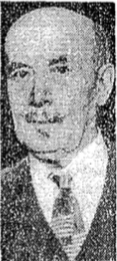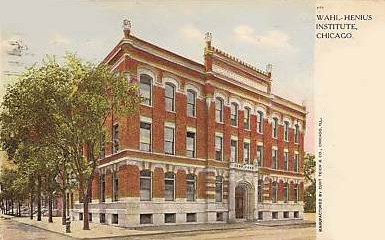Chemist Who Transformed American Brewing Made Pit-stop in Door County
- Share
- Tweet
- Pin
- Share

The headline read “Would Hide Death In Rose.”
“Robert Wahl was accused yesterday of having expressed a desire to kill his wife by the use of a poisonous perfume placed on a rose,” read the first line of the article in the Chicago Tribune dated Jan. 23, 1909. He had second thoughts, however, primarily about his children, and aborted the scheme to kill his wife, Maria Julie Wahl, who had grown tired of his extramarital escapades, which were documented in newspaper accounts and passed down through family lore.
It was the most sensational headline of his Dr. Robert Wahl’s career, but only one of many references to a chemist who transformed the brewing industry in America, with a pit-stop in Door County along the way.
A Scientist First

Robert Wahl escaped to Door County during Prohibition, in part to continue his brewing practices.
Robert Wahl was born in Milwaukee, the son of German immigrants, in 1858. He earned his degree in chemical engineering in Hanover, Germany, where he had a fortuitous meeting with a fellow student named Max Henius. That was followed by a doctorate in philosophy from the University of Marburg, Germany. Wahl persuaded Henius to come to America, and their friendship would lead to a business partnership that would revolutionize brewing in America.
When they first returned to the United States they worked for his father’s business, Wahl Brothers’ Glue Factory. There, Wahl invented a process of producing brewers’ isinglass from calf hide, a gelatin used to clarify beer. The discovery led Wahl to a serious study of the science of brewing that would absorb him for the rest of his life.
Soon Wahl and Henius became business partners, creating the Scientific Station for Brewing of Chicago.
“Henius was the good guy, my great-grandfather was the smart guy,” said Roger Wahl, Robert Wahl’s great-grandson, who has researched the pair’s history. “Max was the head of the Chicago Public Library and other societies.”
Wahl traveled to Europe to learn from the greatest brewing minds of Germany and Copenhagen, where he learned how to capture yeast and get the same brew every time. He came home and introduced the practice of using pure yeast (yeast cultured and optimised for particular brewing uses) in brewing, considered heresy in America at that time. The academy eventually became the Wahl-Henius School of Fermentation, one of the leading brewing schools in the world. Together they authored the American Handy-book of Brewing and Malting, and Auxiliary Trades, which became a bible for a generation of brewers.
In 1905 Wahl earned the scorn of German brewers when he produced research that American six-row barley was superior to that of European two-row barley. The Department of Agriculture was considering introducing the European version to the market, but Wahl convinced them otherwise when his findings were eventually verified by German scientists as well.

The Wahl-Henius Institute of Fermentology in Chicago was one of the world’s leading brewing schools at the turn of the 20th century.
Greg Casey spent his career in the brewing industry at Stroh and MillerCoors. Now retired, he is researching a book on American brewing, and said Wahl is one of the seminal figures in the rise of American beer.
“I give credit to Wahl for protecting the right of brewers to use the ingredients they wanted to use,” Casey said.
Wahl was held in such high esteem that he was pulled into the fight between St. Louis and Chicago regarding the plan to reverse the flow of the Chicago River, sending the city’s foul waters down river. St. Louis leaders claimed it was harming its beers, and Wahl was asked to weigh in on the dispute.
The Chicago Tribune reported that Wahl declared St. Louis’ water “so contaminated that a little Chicago sewage wouldn’t matter much.”
“It’s little short of a miracle that St. Louis has not had an epidemic of typhoid fever all the time,” the Tribune quoted Wahl.
But brewing was his specialty, and his legacy in brewing survives today.
“Americans drink with their eyes,” Casey said. “We like our beer ice cold and in a glass. So finding a way to make it clear was huge. The favorite beer in most countries around the world is still a version of the American light lager. We owe a debt of gratitude to people like Wahl and others like him. He was an important contributor to the legacy of American beer.”
But when Congress ushered in the Prohibition Era with the passage of the Volstead Act, his brewing school was forced to shutter its doors. He sold to the American Institute of Baking, but Wahl didn’t give up his pursuit of brewing perfection.
•••
Behind the building known today as White Cottage Red Door, but still referred to by locals of a certain age as Ray’s Cherry Hut, stand the remnants of an old farm slowly crumbling. The original owner was said to have grown some apples and cherries, but that wasn’t his only interest.
When Bob Armbruster bought the property he said it immediately struck him as curious.
“I thought the windows ringing the top of the silo were a bit strange and asked why they were there,” he said. “I was told they were for lookouts in case the feds came to bust up old Doc Wahl’s bootlegging operation.”
He found dozens of old bottles of the type Wahl might have used, some dated from 1919. One of the Godfathers of American Brewing seems to have practiced his science in exile on a Door County farm.
Casey said the story rings true to the man he has gotten to know in reading his books and archives related to the Wahl-Henius Institute.
“I can’t imagine Robert Wahl giving up his practice, going to Door County, and just looking at trees and birds,” Casey said. “He certainly would have continued experimenting and brewing.”
When Prohibition ended, Wahl quickly returned to Chicago, where he was sought after to test new beer, frequently pictured and quoted in Chicago newspapers. One headline read “Beer Already Has More Kick, Wahl Reports.”
In 1935, when the brewing industry was humming again, 402 of the 700 breweries permitted in the United States were operated by men trained by Wahl.
He re-opened his institute, this time as the Wahl Institute College of Brewing, but his second chance was short-lived. He died in 1937 at age 79. He was still married to Maria.
Maybe they came to an arrangement. Casey said Wahl was known to have mistresses all over the world. Roger Wahl said the family always suspected the farm wasn’t just for growing barley.
“They talked about that farm all the time,” he said, referring to family stories. “He’d grow his barley at the farm and study at the farm. We always figured the farm was where he was cheating on his wife.”

